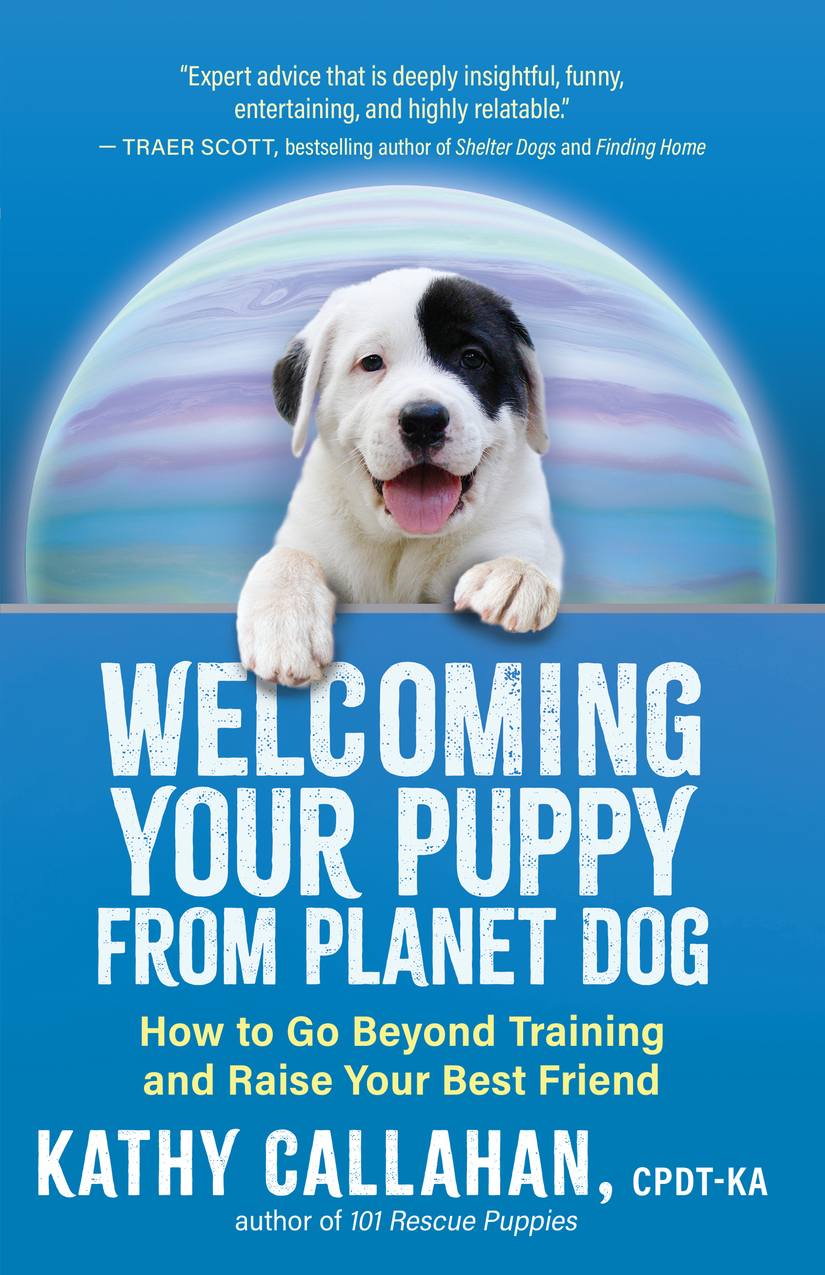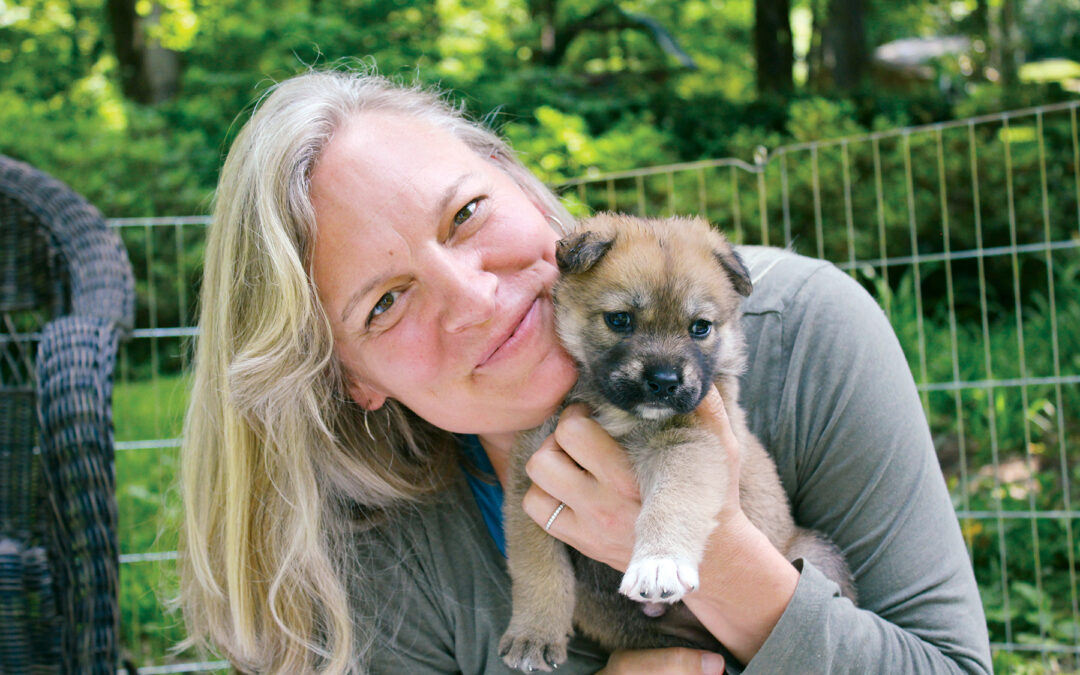Kathy Callahan, cpdt-ka, fdm, is an experienced certified professional dog trainer. Her family has fostered more than 200 at-risk puppies, and her first book with New World Library, 101 Rescue Puppies, features those heartwarming stories. Callahan writes monthly on training and behavior for Whole Dog Journal, cohosts the training podcast Pick of the Litter, and occasionally writes on dogs for her local newspaper, the Zebra. She runs PupStart, a puppyhood coaching, socialization, and training business in Alexandria, Virginia. More information at PuppyPicks.com.
You tell owners to think of their puppy as a baby they kidnapped from another planet. Why?
A few weeks after bringing home a new puppy, people often come to me and confess: Maybe this was a mistake. This was supposed to be fun, but all I feel is stress. They’re at their wit’s end with the peeing, the destruction, and the sharp puppy teeth.
I’m not surprised. A real, live puppy doesn’t fit nicely into a pre-puppy life, and trying to make it so is a recipe for angst. The way to enjoy puppyhood — and to emerge from it with a beautiful two-way friendship — is to dive in and get into the right headspace. Think of the puppy as a baby from another planet, taken away suddenly from his own tribe. As you ponder that, it creates the guiding empathy that turns out to be the best puppy training trick out there.
Typically, until the day our puppies come “home,” they have spent every moment of their lives in a warm, cozy family scrum. We take them from their fun littermates, where they were happily digging and biting and wrestling all day long, and we plunk them down in our human world. We immediately begin with the “no’s” as we discipline them for things that are as natural as breathing in their culture. It’s almost as if we’re angry at them for being . . . dogs. But when an owner has adopted the kidnapped baby mindset, he’ll no longer think “ugh, this stubborn puppy won’t do what I want.” Instead, he’ll wonder, “what is this confused little guy feeling”? That curiosity proves to be the pathway to building the trusting relationship that will lead to wonderful behavior.
What’s the most important thing to teach a puppy?
People assume the answer to this is:
- Where to go to the bathroom
- How to respond to cues like sit
- How to walk on a leash (continued)
I do want to teach all of those things, but there’s one key lesson that comes first, and provides the foundation for learning the rest. It’s this: You’re safe here, with me.
A puppy who doesn’t feel secure can’t learn much at all, so this has to be our starting point. The move from Planet Dog to Planet Human is confusing and scary. A puppy needs a guide who makes him feel safe, who makes this new world feel predictable. Convincing your puppy you’re his rock is Task #1. So how do you do that?
First, learn about body language. A puppy is “talking” all the time — be the one who listens. Second, be calm and consistent. You can’t be your puppy’s trusted guide if one minute you’re sweetly cuddling and the next you’re flying off the handle. Instead, anticipate the realities of puppyhood, and set things up – the environment, the routine, the plan – so that it mostly goes right, and you can be the rock-solid reassuring adult in the room.
You don’t include any tips on how to discipline a puppy. Why not?
It’s so much more effective (and more fun!) to build a world filled with Yes’s!
Sometimes people tell me they need my help because their puppy “just doesn’t understand the word no.” Their instinct is to become more punitive (say it louder! Sound meaner! Stomp off!) to make the meaning of the word clearer.
Do you ever wonder what it feels like to be a puppy — born with very strong instincts to jump, dig, chase, bark and chew — and to have everyone mad at you all the time for being who you are? To hear “No” all day long, in your only home? From the human who is supposed to be the one you can trust here?
If a puppy is often hearing “no,” then she’s not being set up for success. Instead of letting our kidnapped puppies stumble around bumping into all of the No’s on Planet Human, I’d prefer to give them a brightly lit path to “Yes.” (continued)
What have we had wrong about training puppies?
The dog training industry has always focused on . . . the owners. In pursuit of behavior that pleases humans, classes teach “commands.” Puppies need to “obey” when told to sit/down/stay/come/heel. There is often an “or else…” built in.
That old-fashioned approach is likely to hurt your relationship, and it’s also not going to work very well! There’s a much kinder, happier way to wind up with the behavior you want!
Living happily with your dog starts not with what you want but who your puppy is. As you begin to understand your puppy’s canine nature, you’ll realize you need to meet his fundamental needs before you begin to ask him to fit into our lifestyle. Instead of immediately forcing sits and stays, a great trainer will be teaching an owner to ask herself: “Has my puppy gotten to be a dog yet today?” Finding ways to build in doggy play, digging, chewing, sniffing etc. into every day is like making sure the 3rd grade boys get out for recess before expecting them to sit still and do their math worksheet. It sets everybody up for success. (continued)
What’s the biggest misconception people have before they get a puppy?
If you Google “puppy and child” you’ll inevitably be bombarded with photos of gorgeous children with sweet puppies meandering through a field, lit by the sun at golden hour.
I would like to remove every one of those shots from the Internet. I’d also like to cancel all of the movies and TV shows that introduce a dog adorably in Scene 3, and then never show him again.
Out there swirling in the collective unconscious seems to be the vision of a perfect dog who completes the family, makes everyone feel loved, appears just in time for walks or a cozy night in front of the fire, but disappears the rest of the time.
Real dogs are real time-consumers. There’s no way around that. You’re either putting in the time doing it right (and enjoying it!), or you’re playing whack-a-mole because you keep trying to put the dog on the back burner but a new problem pops up as a result.
What are the biggest challenges new puppy owners feel in the first weeks?
If an owner is tossing at turning at night thinking that this may have been a mistake, it’s probably because of the two classic Month #1 issues: Tinkle & Teeth.
Everyone has good intentions when it comes to potty training, but the 24/7 nature of the task quickly feels overwhelming. The mistakes then come faster and faster, the wrong patterns are set, and they’re in trouble. Cue the household stress and recriminations! It doesn’t have to be that way! Potty training can’t be made easy, but it IS simple: stick to the plan 100% if you want to be done early.
The sharp puppy teeth often come as a shock: How can that sweet ball of fluff inflict so much pain? Nothing’s more natural for a puppy than using her mouth to investigate the world. Sure, you could spend all day (ineffectively) saying “no” . . . of you could set the two of you up for success with a plan for managing biteyness.
What’s the biggest challenge puppy owners are NOT thinking about but should be?
There is a lot that feels urgent to a new puppy owner: potty training, getting the pup to sleep through the night, preventing that chair leg from being chewed, etc. In the face of all of that immediacy, it’s hard to prioritize socialization.
The thing is, that’s one we can’t put off. While a dog can always learn new things, early puppyhood offers a special opportunity to learn fast and forever. In essence, if you can influence a young puppy to feel that new things aren’t scary, it will dramatically increase the odds that as an adult dog he’ll be able to roll with new situations. That’s a game-changer.
While it’s great that a message about the importance of socialization has filtered out to the general public, it has been simplified in a potentially harmful way. Exposure alone does not equal socialization. (continued)
Yes, in the first months, puppies need to get out and about so that they can experience lots of things . . . but the key is that the exposure must be at the level of intensity that’s exactly right for them. The experience has to feel positive for it to work as socialization. Owners need to watch that body language, and adjust accordingly, so that puppy can build a database of information and decide that life here on Planet Human is just fine.
What’s the most underrated puppy tip?
Thinking ahead! Part of the reason puppyhood feels so difficult to people is that they are constantly surprised by events. They’re busy cleaning up the pee on the floor and turn around to see the pup’s been chewing their book in the meantime. They go to put the book up high and their preschooler runs into the room only to be knocked over by the exuberant pup.
None of that had to happen!
There are classic times of day that will be chaotic with a puppy: getting ready for work and school, after school greetings, guests coming over, dinner hour. The key is to have a plan for each. Visualize it. Use management strategies involving gates, pens, crates, doors and leashes! Where will the puppy be? (continued)
If we’re crating him, has he had enough exercise beforehand? Do we have stuffed Toppls and Kongs in the freezer to keep him content when he’s confined?
Thoughtful anticipation and management reduce a large majority of puppy stress! It may seem like it takes a lot of time to plan ahead, but it doesn’t. We all lead pretty routine lives, and once we think through a pattern for each scenario, it becomes an easy routine. Pup thinks so too.
Some of your teaching seems to take a lot of time — isn’t there a faster way?
It does tend to take a little time to train using positive reinforcement. What’s nice is that the journey tends to be fun and builds trust along the way.
You know what works faster? Using pain and fear. It takes almost no time and zero skill to make a dog stop jumping up if you’re willing to hurt or scare him in the process.
I’m not.
You know what they use to teach a walrus to submit to a tooth examination? Positive reinforcement. It’s extraordinary what humans have been able to get giant captive animals to do using force-free techniques. So why would we not use proven, scientifically based techniques that happen to be kind to work with our best friends?

Welcoming Your Puppy from Planet Dog:
How to Go Beyond Training and Raise Your Best Friend
By Kathy Callahan, cpdt-ka
Pub date: April 16, 2024 * Dog Training • $18.95
Trade paperback * 256 pp.
ISBN: 978-1-60868-921-7 * Also available as an ebook





